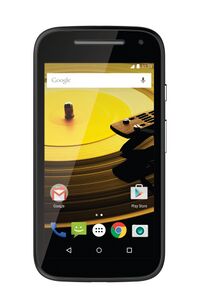Motorola Moto E 2015 (motorola-surnia): Difference between revisions
m rollbackEdits.php mass rollback Tag: Rollback |
No edit summary |
||
| Line 18: | Line 18: | ||
| status_usbnet = Y | | status_usbnet = Y | ||
| status_flashing = Y | | status_flashing = Y | ||
| status_touch = | | status_touch = Y | ||
| status_screen = P | | status_screen = P | ||
| status_wifi = Y | | status_wifi = Y | ||
Revision as of 02:53, 15 June 2023
| This device was just changed from downstream to mainline. Supported features is roughly correct. Many other sections may not be, please update if you can. |
 Motorola Moto E (2nd Gen) | |
| Manufacturer | Motorola |
|---|---|
| Name | Moto E (2nd Gen) |
| Codename | motorola-surnia |
| Released | 2015 |
| Hardware | |
| Chipset | Qualcomm Snapdragon 410 (MSM8916) |
| CPU | Quad-core 1.2 GHz Cortex-A53 |
| GPU | Adreno 306 |
| Display | 540x960 IPS LCD |
| Storage | 8 GB Flash |
| Memory | 1 GB |
| Architecture | aarch64 |
| Software | |
| Original software | Android 5.0.2 Lollipop |
| postmarketOS | |
| Category | testing |
| Pre-built images | no |
| Mainline | yes |
| postmarketOS kernel | 3.10.49 |
| Flashing |
Works |
|---|---|
| USB Networking |
Works |
| Internal storage |
No data |
| SD card |
No data |
| Battery |
Partial |
| Screen |
Partial |
| Touchscreen |
Works |
| Multimedia | |
| 3D Acceleration |
No data |
| Audio |
No data |
| Camera |
No data |
| Camera Flash |
No data |
| Connectivity | |
| WiFi |
Works |
| Bluetooth |
Partial |
| GPS |
No data |
| NFC |
No data |
| Modem | |
| Calls |
No data |
| SMS |
Partial |
| Mobile data |
No data |
| Miscellaneous | |
| FDE |
No data |
| USB OTG |
Partial |
| HDMI/DP |
No data |
| Sensors | |
| Accelerometer |
No data |
| Ambient Light |
No data |
| Proximity |
No data |
| Hall Effect |
No data |
| Haptics |
No data |
| This device is based on the Snapdragon 410. See the SoC page for common tips, guides and troubleshooting steps |
Contributors
Users owning this device
- BogdanTheGeek (Notes: Running android for now)
- Chipmunk (Notes: XT1526; unlocked bootloader, runs LineageOS 17.1)
- Dominduchami
- Frbrr02 (Notes: Model: XT1524)
- Icenowy
- Illen (Notes: Dying battery, runs mainline.)
- Pangelo (Notes: cracked screen but works fine)
- Proycon
- Rsquared (Notes: msm8916 - working inx panel!)
- Techwizz (Notes: Mainline testing)
- Thenightterrorx (Notes: boots fine off sd card)
- UnDevDeCatOS (Notes: is currently being lend to someone else)
- Unrznbl (Notes: 2023-12-01 mainline, gestures fixed in shelli-ui last year)
- Wiktorek140
- Xonney1 (Notes: Cracked screen, functional)
- Yeswap (Notes: Edge Phosh)
Unlocking the bootloader
Please visit the Motorola website for instructions. You will need a email address for only receiving email (disposable email is enough) and working fastboot (driver installation needed for Windows and macOS, works out of the box on Linux).
How to enter flash mode
Hold down + while booting to enter Flash Mode.
Installation
First, flash lk2nd-msm8916.img to the boot partition.
Boot that, press volume down during that booting to get to the lk2nd boot menu.
See Usage for lk2nd.
After that, use the normal Installation_guide
Installation to directly to device and sdcard have both been tested to work.
Display
The display panel works fine on some devices but not on others due to hardware differences.
Modem Setup (same as for motorola-harpia so far)
Content below copied from https://wiki.postmarketos.org/wiki/Moto_G4_Play_(motorola-harpia).
I used these steps to configure and test SMS. It sort of worked I think. Need to do more testing.
Wifi
Configure your kernel and enable the prima wifi staging driver
$ pmbootstrap menuconfig motorola-harpia
$ pmbootstrap build linux-motorola-harpia
On the device
# apk add wcnss-wlan
# /etc/init.d/wcnss-wlan start
Bluetooth (Mainline)
Using unrznbl's tree. bluetoothctl detects controller and pairing works. Still needs some testing to see if it is stable.
Battery (Mainline)
Battery fuel gauge is supported, but fan54046 charging chip isn't. It does still charge but it dosen't indicate that it is charging.
USB OTG (Mainline)
The internal USB hub shows up, but it dosen't detect any USB devices.
Firmware {Wifi/Modem}
The firmware is now properly packaged since pmaports!1947
Modem
Make the necesary links for rmtfs
# cd /boot
# ln -s /dev/disk/by-partlabel/modemst1 modem_fs1
# ln -s /dev/disk/by-partlabel/modemst2 modem_fs2
# ln -s /dev/disk/by-partlabel/fsg modem_fsg
Install necessary software
# apk add msm-modem-downstream rmtfs libsmdpkt_wrapper libqipcrtr4msmipc ofono
Start the wcnss-wlan service to initialize the wifi card (helps the modem?)
# /etc/init.d/wcnss-wlan start
Start a tmux for multiple windows
tmux
Start rmtfs on a terminal
export LD_PRELOAD=/usr/lib/preload/libqipcrtr4msmipc.so
rmtfs -vStart ofonod on another terminal
$ export LD_PRELOAD=/usr/lib/preload/libsmdpkt_wrapper.so
$ ofonod -d -n
Send an SMS!
$ export PHONE_NUMBER="<number to send sms to ex: 1234567890>"
$ sudo dbus-send --print-reply --system --dest=org.ofono /gobi_0 org.ofono.Modem.SetProperty string:"Powered" variant:boolean:"true"
$ sudo dbus-send --print-reply --system --dest=org.ofono /gobi_0 org.ofono.Modem.GetProperties
$ sudo dbus-send --print-reply --system --dest=org.ofono /gobi_0 org.ofono.Modem.SetProperty string:"Online" variant:boolean:"true"
$ sudo dbus-send --system --print-reply --dest=org.ofono /gobi_0 org.ofono.MessageManager.SendMessage string:"$PHONE_NUMBER" string:"Hello world! -postmarketOS"
Receive SMS like this (might be spammy if you have other DBus apps):
$ sudo dbus-monitor
Hardware / sensors detail
For reference, sensor information from sensorsandbox (f-droid) on xt1526; note that in addition to hardware-based sensors, it presumably includes software-based / derived sensors:
sensor details (sensorssandbox)
See also
- Display issue
- pmaports!3329 Switch from downstream to mainline. 2022-09-14.
- Device package
- Kernel package
- Firmware package